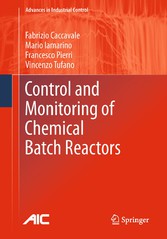Suchen und Finden
Series Editors' Foreword
9
Preface
11
Acknowledgements
13
Contents
14
Introduction
17
Overview of the Main Topics
17
The Batch Reactor
18
The Case Study
19
Identification of Mathematical Models
20
Thermal Stability
20
Control of Batch Reactors
21
Fault Diagnosis for Chemical Batch Reactors
22
Applications to Non-ideal Reactors
23
Suggested Reading Paths
23
The Chemical Batch Reactor
24
Ideal Chemical Reactors
25
The Rate of Chemical Reactions
27
The Ideal Batch Reactor
30
Conservation of Mass
31
Conservation of Energy
35
Introducing the Case Study
37
Components
39
Reactions
40
A General Model for a Network of Nonchain Reactions
42
Measuring the Reactor Status
46
Measurements Quality
47
Online Measurements
47
Offline Measurements
50
Manipulating the Reactor Status
50
Conclusions
52
References
52
Identification of Kinetic Parameters
54
Bayesian Approach and Popper's Falsificationism
56
Experimental Data and Mathematical Models
58
Maximum Likelihood and Least Squares Criteria
60
Optimization for Models Linear in the Parameters
63
Optimization for Models Nonlinear in the Parameters
65
Steepest Descent Algorithm
65
Newton-Raphson Algorithm
66
Levenberg-Marquardt Algorithm
67
Implicit Models
68
Statistical Analysis of the Results
69
Case Study: Identification of Reduced Kinetic Models
71
Reduced Models
71
Generation of Data for Identification
73
Estimating the Kinetic Parameters
74
Estimating the Heats of Reaction
76
Validation of the Reduced Models
77
Conclusions
80
References
81
Thermal Stability
83
Runaway in Chemical Batch Reactors
84
Dimensionless Mathematical Model
85
Adiabatic Reactor
88
Isoperibolic Reactor
89
The Semenov Theory
90
Geometry-based Runaway Criteria
93
Sensitivity-based Runaway Criteria
96
Operation Limited by the Maximum Allowable Temperature
98
Case Study: Runaway Boundaries
99
Conclusions
101
References
101
Model-based Control
103
Control Strategies for Batch Reactors
105
PID Regulator
106
Model Predictive Control
107
Feedback Linearization
109
Input-Output Linearization
109
Generic Model Control
110
State-Space Model for Control Design
111
Estimation of the Heat Released by Reaction
113
Model-Based Nonlinear Observer
114
Model-Free Approaches
116
Approach Based on Universal Interpolators
116
A Classical Model-Free Approach
118
Adaptive Two-Loop Control Scheme
118
Case Study: Temperature Control
122
Simulation Model
123
Design of the Controller-Observer Scheme
124
Discussion of Results
125
Comparison with the PID Controller
127
Conclusions
130
References
131
Fault Diagnosis
135
Fault Diagnosis Strategies for Batch Reactors
136
Model-Free Approaches
137
Model-Based Approaches
138
Basic Principles of Model-Based Fault Diagnosis
139
Residual Generation
141
Decision Making System and Fault Isolation
142
Fault Diagnosis for Chemical Batch Reactors
143
Fault Characterization
143
Architecture of the Fault Diagnosis Scheme
145
Sensor Fault Diagnosis
147
Residuals Generation and Fault Isolation
149
Determination of the Healthy Signal
150
Voter procedure
150
Actuator and Process Fault Diagnosis
152
Fault Detection
152
Fault Isolation and Identification
154
Decoupling Sensor Faults from Process and Actuator Faults
157
Case Study: Fault Diagnosis
157
Simulation Results: Sensor Faults
158
Simulation Results: Process and Actuator Faults
162
Simulation Results: Sensor and Actuator Faults
166
Conclusions
169
References
169
Applications to Nonideal Reactors
173
Nonideal Batch Reactors
174
Nonideal Mixing
175
Multiphase Batch Reactors
179
Scaling-up the Information
180
Basic Ideas of Scale-up
180
The Scale-up of Real Batch Reactors
182
Suggestions and Conclusions
183
References
184
Appendix A Proofs
185
Proof of Theorem 5.1
185
Proof of Theorem 5.2
187
Proof of Theorem 5.3
188
Proof of Theorem 5.4
189
Proof of Theorem 6.1
190
Proof of Theorem 6.2
192
References
194
Index
195
Alle Preise verstehen sich inklusive der gesetzlichen MwSt.




















